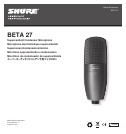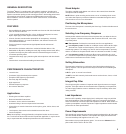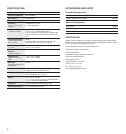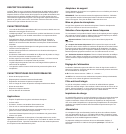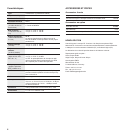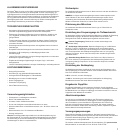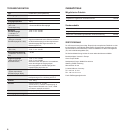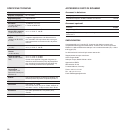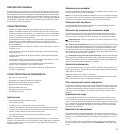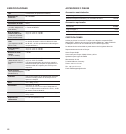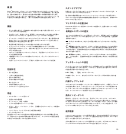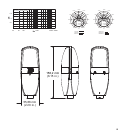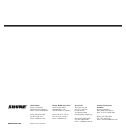
3
GENERAL DESCRIPTION
The Shure
®
Beta 27 is a studio-grade, side-address condenser microphone for
professional sound reinforcement. Its flat frequency response, low self noise, and
superior construction quality provide unerring precision in demanding performance
and recording environments. A tight supercardioid pattern ensures high gain-
before-feedback, maximum isolation from other sound sources, and consistent
off-axis rejection.
FEATURES
• Supercardioid polar pattern targets intended sound source with minimized bleed
from off axis sound sources
• 1inch,externallybiased,ultra-thin,2.5μm,24Karatgold-layered,lowmass,
Mylar
®
diaphragm provides superior transient response
• Class A, discrete, transformerless preamplifier for transparency, extremely
fast transient response, no crossover distortion, and minimal harmonic and
intermodulation distortions
• Premium electronic components and gold-plated internal and external
connectors
• Subsonic filter eliminates rumble from mechanical vibration below 17 Hz
• Switchable 15 dB pad for handling extremely high sound pressure levels (SPLs)
• 3-position low-frequency filter switch reduces unwanted background noise or
counteracts proximity effect
• Integrated three-stage “pop” protection grille reduces plosives and other breath
noise
• Internal shock mount reduces handling and stand noise
PERFORMANCE CHARACTERISTICS
• Low self-noise
• Consistent, highly directional polar response
• Exceptional low-frequency reproduction
• Extremely high SPL handling
• High output level
• Extended frequency response
• No crossover distortion
Stand Adapter
Thread the supplied stand adapter onto a floor or boom stand, then thread the
microphone onto the adapter.
NOTE: When in quiet recording environments, use of an isolating shock mount
can reduce low-frequency mechanical vibrations transmitted through the stand.
Visit www.shure.com for more information.
Positioning the Microphone
The front of the microphone is marked by the Shure logo. Position this side toward
the sound source.
Selecting Low-Frequency Response
A three-position switch on the back of the microphone lets you adjust the low-fre-
quency response. Use the low-frequency filter to reduce wind noise, room noise,
or proximity effect.
Flat response. Provides the most natural sound in most applications.
Low frequency cutoff. Provides an 18 dB-per-octave cutoff at 80 Hz. Helps
eliminate floor rumble and low-frequency room noise from heating and air
conditioning systems. This setting may also be used to compensate for proximity
effect or to reduce low frequencies that make an instrument sound dull or muddy.
Low frequency rolloff. Provides a 6 dB-per-octave rolloff filter at 115 Hz.
Use this to compensate for proximity effect or to reduce low frequencies that
could make an instrument sound dull or muddy.
Setting Attenuation
The attenuation switch lets you reduce the signal level without altering the fre-
quency response. This can prevent extremely loud sounds from overloading the
microphone.
0 dB For “quiet” to “normal” sound levels.
-15 dB For use with extremely loud sound sources such as drums, horns, or loud
guitar cabinets.
Load Impedance
Maximum SPL capability, output clipping level, and dynamic range vary with the
input load impedance of the preamplifier to which you connect the microphone.
Shurerecommendsaminimuminputloadimpedanceof1000Ω.Mostmodernmi-
crophone preamplifiers meet this requirement. Higher impedance results in better
performance for these specifications.
Applications
• Electric guitar and bass amplifiers
• Brass and woodwind instruments
• Orchestras, choirs, and wind ensembles
• Overhead miking of drums and percussion instruments
• Close-miking of acoustic instruments such as piano, guitar, violins, drums, and
percussion
• Low-frequency instruments such as double bass and kick drum
• Vocals and speech
Note: Sound quality is strongly affected by microphone location and room acous-
tics. To achieve the best overall sound for a particular application, it may be neces-
sary to experiment with microphone placement and room treatments.
Integral Pop Filter
The microphone grille consists of 3 separate mesh layers that act as an integral
pop filter. This helps reduce wind and breath noise. Depending on the performer,
an external pop-protection screen or windscreen may be necessary when close-
miking vocalists.
Power Requirements
Thismicrophonerequiresphantompowerandperformsbestwitha48Vdcsupply
(IEC-268-15/DIN45596).However,itwilloperatewithslightlydecreasedhead-
room and sensitivity with supplies as low as 11 Vdc.
Most modern mixers provide phantom power. You must use a balanced micro-
phone cable: XLR-to-XLR or XLR-to-TRS.



